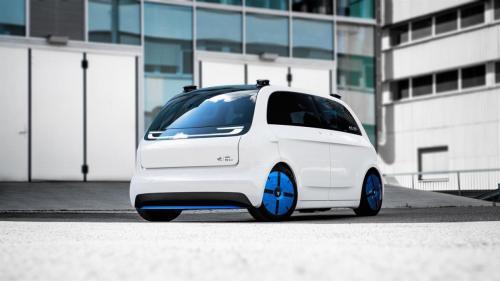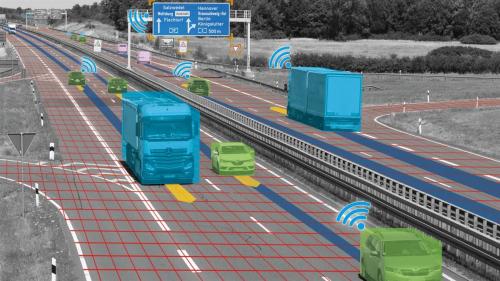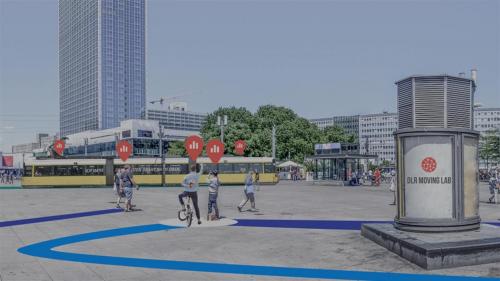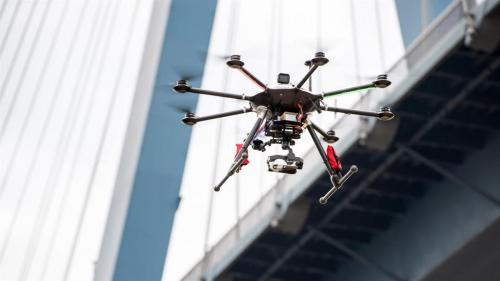DLR at IAA New Mobility World 2019
Automated, networked and fascinating
The prototype of an intelligent, modular electric urban car, infrastructure with high-tech sensors for testing automated and networked vehicles, and measuring mobility behaviour with smartphones – at IAA New Mobility World, the German Aerospace Center (Deutsches Zentrum für Luft- und Raumfahrt; DLR) will be presenting forward-looking technologies and projects for tomorrow’s mobility. From 10 to 15 September 2019, visitors to the DLR stand (Hall 5, D04) will experience how automated and networked driving enables new mobility concepts and thus makes the transport system smarter, more sustainable, safer, more efficient and more user-friendly.

UMV People Mover 2+2.
“The aim of DLR’s transport research is to work with partners from industry, science and government to develop practical solutions to meet the requirements of our increasingly mobile world. Our researchers always examine all levels of the overall transport system – from the vehicle to the infrastructure to the human participants. This system-level competence makes DLR unique,” explains Karsten Lemmer, DLR Executive Board Member for Energy and Transport.

Lower Saxony Test Field.
Urban Modular Vehicle (UMV) – All-rounder in urban traffic

Moving Lab.
The requirements for the urban vehicle of tomorrow are stringent and varied. It must be able to drive autonomously and be electrically powered; it also has to meet strict safety standards, be comfortable as well as flexible and cost-efficient to manufacture. With the Urban Modular Vehicle (UMV), transport researchers at DLR have completely rethought the urban car of the future – with the aim of bringing innovations in the mobility sector onto the road quickly and cost-effectively.

Camera drone of the City-ATM project.
The highlight is that the eight different variants of the UMV family – from a small urban car to the larger autonomous People and Cargo Mover versions – are built on a standardised platform. The length of the floor module can be adjusted, and the front and rear modules are standard. The centre of the vehicle is variable and changes depending on the intended use. At IAA New Mobility World, DLR is showing a drivable prototype for the first time – the UMV People Mover 2+2. It can accommodate four passengers and is designed to be used as an autonomous shuttle in urban areas.
Lower Saxony Test Field – research infrastructure for autonomous and networked driving
The Lower Saxony Test Field provides DLR and its partners from industry and government with a unique research infrastructure for developing and testing technologies for automated and networked driving - from simulation to routes for test driving with prototype vehicles in public spaces. The test field covers a total distance of approximately 280 kilometres. Extensive camera and sensor systems record driving behaviour and traffic flow from above – primarily on motorways, but also in the centre of Braunschweig. In this way, scientists can simulate scenarios for the introduction of automated and networked vehicles or conduct practical tests of the effectiveness of new traffic services and intelligent infrastructure components.
Moving Lab – analysing mobility using smartphones
In order to draw conclusions about the mobility behaviour of individuals and groups of people and to create traffic models and forecasts, researchers need reliable data. With the Moving Lab, DLR has developed a new survey and analysis method that uses what most people always have with them – smartphones and other smart devices. The location and motion sensors built into these devices can determine a person’s exact position several times a minute. The Moving Lab uses location changes to create acceleration profiles that indicate the use of a particular means of transport. The system automatically and reliably detects all routes, the means of transport used, as well as transfer and staging points. The significantly lower effort for study participants – compared to conventional route diaries – enables long-term studies, which are supplemented by surveys on new mobility concepts and offers.
Taking off into the third dimension – airspace management in urban areas
In future, traffic management in cities will no longer concentrate only on surface transport, but will also include the third dimension, airspace. New transport system components such as drones and air taxis must be integrated into the mobility concept and controlled accordingly. In the City-ATM (air traffic management) project, DLR is testing concepts for airspace management and traffic control in urban areas using a hexacopter specially equipped for this purpose. In addition, the researchers are developing operating concepts for unmanned aerial vehicles and defining requirements such as general conditions for safe operation in civil airspace.
Source: German Aerospace Center
- 276 reads
Human Rights
Fostering a More Humane World: The 28th Eurasian Economic Summi

Conscience, Hope, and Action: Keys to Global Peace and Sustainability

Ringing FOWPAL’s Peace Bell for the World:Nobel Peace Prize Laureates’ Visions and Actions

Protecting the World’s Cultural Diversity for a Sustainable Future

Puppet Show I International Friendship Day 2020

